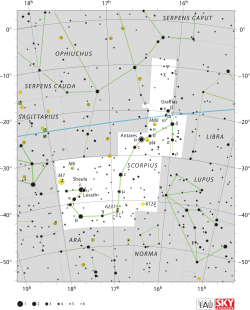| Observation data Epoch J2000.0 Equinox J2000.0 |
|
|---|---|
| Constellation | Scorpius |
| HR 5984 | |
| Right ascension | 16h 05m 26.23198s[1] |
| Declination | –19° 48′ 19.6300″[1] |
| Apparent magnitude (V) | 2.63[2] |
| HR 5985 | |
| Right ascension | 16h 05m 26.57128s[1] |
| Declination | –19° 48′ 06.8556″[1] |
| Apparent magnitude (V) | 4.92[2] |
| Characteristics | |
| Spectral type | B0.5V + B2V[3] |
| U−B color index | –0.08 / –0.70[2] |
| B−V color index | –0.08 / –0.02[2] |
| Astrometry | |
| HR 5984 | |
| Radial velocity (Rv) | –1.0[4] km/s |
| Proper motion (μ) | RA: –5.20[1] mas/yr Dec.: –24.04[1] mas/yr |
| Parallax (π) | 8.07 ± 0.78[1] mas |
| Distance | 400 ± 40 ly (120 ± 10 pc) |
| HR 5985 | |
| Radial velocity (Rv) | –3.6[4] km/s |
| Proper motion (μ) | RA: –5.07[1] mas/yr Dec.: –25.87[1] mas/yr |
| Parallax (π) | 8.19 ± 1.17[1] mas |
| Distance | 400 ± 40 ly (approx. 120 pc) |
| Details | |
| HR 5984 | |
| Mass | 10[5] M☉ |
| Radius | 19 R☉ |
| Luminosity | 20,000[5] L☉ |
| Temperature | 27,000[5] K |
| Rotational velocity (v sin i) | 100[6] km/s |
| HR 5985 | |
| Temperature | 22,000[5] K |
| Rotational velocity (v sin i) | 65[6] km/s |
| Other designations | |
Beta Scorpii (β Sco, β Scorpii) is a multiple star system in the southern zodiac constellation of Scorpius. It has the traditional names Acrab, Akrab or Elacrab, all come from (Arabic: العقرب) al-'Aqrab, the Scorpion, for the whole constellation, as well as Graffias, a name it shares with Xi Scorpii. It was known as 房宿四 (the Fourth Star of the Room) in Chinese.

Observed through a small telescope, Beta Scorpii appears as a binary star with a separation between the two components of 13.5 arcseconds. This pair, β1 and β2, form the top branches of the hierarchy of orbiting components in this system. β1 Scorpii, the brighter of the pair, consists of two sub-components, β Sco A and β Sco B, orbiting at an angular separation of 3.9 arcseconds with an orbital period of 610 years. β Sco A is itself a spectroscopic binary with the components β Sco Aa and β Sco Ab separated by 1.42 milliarcseconds and an orbital period of 6.82 days.[8]
The second visual component, β2 Scorpii, has two sub-components, β Sco C and β Sco E, orbiting at an angular separation of 0.1328 arcseconds with an orbital period of 39 years. β Sco E is a spectroscopic binary with the components β Sco Aa and β Sco Ab having an orbital period of 10.7 days. This brings the total number of stars in the system to six. There is no D component; this is now an artifact of earlier system models.[8]
The two most massive members of the system have the spectrum of B-type main sequence stars. Component C has a stellar classification of B2V.[8] They are both hot stars at least 10 times as massive as our own Sun, and will have short lives. Both are expected to end their stellar evolution with massive Type II supernova explosions.
Because it is close to the ecliptic, Beta Scorpii can be occulted by the Moon and, very rarely, by planets. The last occultation by a planet took place on 13 May 1971, by Jupiter.
In culture [link]
Graffias appears on the flag of Brazil, symbolising the state of Maranhão.[9] USS Graffias (AF-29) is once of United States navy ship.
References [link]
- ^ a b c d e f g h i j van Leeuwen, F. (November 2007), "Validation of the new Hipparcos reduction", Astronomy and Astrophysics 474 (2): 653–664, Bibcode 2007A&A...474..653V, DOI:10.1051/0004-6361:20078357
- ^ a b c d Johnson, H. L. et al. (1966), "UBVRIJKL photometry of the bright stars", Communications of the Lunar and Planetary Laboratory 4 (99), Bibcode 1966CoLPL...4...99J
- ^ Houk, Nancy (1978), Michigan catalogue of two-dimensional spectral types for the HD stars, 4, Ann Arbor: Dept. of Astronomy, University of Michigan, Bibcode 1988mcts.book.....H
- ^ a b Evans, D. S. (June 20–24, 1966), Batten, Alan Henry; Heard, John Frederick, ed., The Revision of the General Catalogue of Radial Velocities, University of Toronto: International Astronomical Union, https://adsabs.harvard.edu/abs/1967IAUS...30...57E, retrieved 2009-09-10
- ^ a b c d Kaler, James B.. "GRAFFIAS (Beta Scorpii)". University of Illinois. https://stars.astro.illinois.edu/sow/graffias.html. Retrieved 2010-02-20.
- ^ a b Abt, Helmut A.; Levato, Hugo; Grosso, Monica (July 2002), "Rotational Velocities of B Stars", The Astrophysical Journal 573 (1): 359–365, Bibcode 2002ApJ...573..359A, DOI:10.1086/340590
- ^ Allen, R. H., (1899) Star-names and Their Meanings, New York: G. E. Stechert, p. 367.
- ^ a b c d Mason, Brian D.; Hartkopf, William I.; Tokovinin, Andrei (September 2010), "Binary Star Orbits. IV. Orbits of 18 Southern Interferometric Pairs", The Astronomical Journal 140 (3): 735–743, Bibcode 2010AJ....140..735M, DOI:10.1088/0004-6256/140/3/735
- ^ "Astronomy of the Brazilian Flag". FOTW Flags Of The World website. https://www.fotw.net/flags/br_astro.html.
External links [link]
|
|||||||||||||||||
https://wn.com/Beta_Scorpii
Podcasts:
-
by Acrybia
-
by Acrybia
-
by Acrybia
-
by Acrybia
-
by Acrybia
-
by Acrybia
-
by Acrybia
-
by Acrybia
-
by Acrybia
-
by Acrybia
-
by Acrybia
-
by Acrybia
-
by Acrybia
-
by Acrybia
-
by Acrybia
-
by Acrybia
-
by Acrybia
-
by Acrybia
-
by Acrybia
-
by Acrybia
-
by Acrybia
-
by Acrybia
Nothing Extreme
by: AcrybiaIn the blind dimmension
I'm devoting inconsistency
Intern palpitation
Of groundless habits
The poacher of my sights
Thurst unusually crass methods
Partly lost passion
Throughly hidden sentiments
I purvey
Your senses collapse endlessly
I bond
I purse
I pander
There's nothing extreme in this
Only fools can't see
Beauty
In the shadows of


